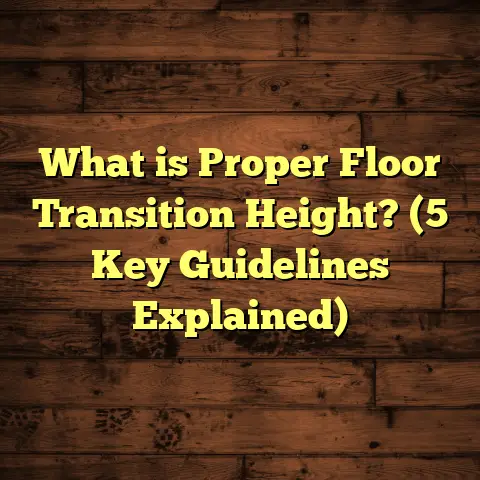What is a Monolithic Floor? (5 Facts You Need to Know)
When you start thinking about flooring options, budget usually jumps to the top of the list. I’ve been there myself when helping clients figure out what fits their wallet without compromising on quality. It can feel overwhelming—there are so many choices out there. But sometimes the simplest solution is the best one. That’s how I first got interested in monolithic floors. They offer a solid, seamless, and surprisingly affordable option for many projects.
If you’re reading this, maybe you’re considering a new floor but want something durable, cost-effective, and low maintenance. Or maybe you just want to understand what monolithic floors are all about before making a choice. Either way, I’ve gathered everything useful I know about this topic after years of experience and research. So let’s get into it—starting with the basics.
What Is a Monolithic Floor?
At its core, a monolithic floor is a continuous slab of material—usually concrete—that’s poured or cast in one single piece. The word “monolithic” literally means “made of one stone” or “one single piece.” So unlike floors made from separate tiles, planks, or panels, monolithic floors have no joints, seams, or breaks.
Imagine pouring a giant pancake batter all at once into a pan versus placing dozens of small pancakes side by side. The monolithic floor is that giant pancake—one smooth, solid surface.
Most commonly, monolithic floors are made from concrete or cement-based materials. But there are variations where polymers or special additives are mixed in to boost strength, flexibility, or finish options.
Once poured and cured, this single slab forms an incredibly strong and uniform surface. This is why these floors are often used in industrial settings, warehouses, commercial spaces—and increasingly in residential homes that want durability without fuss.
Why This Matters
I’ve worked on many projects where clients needed floors that could stand up to heavy use without cracking or needing repairs every few years. Monolithic floors came through consistently. Because they’re seamless, they don’t have weak points that tend to crack under stress.
Here’s the kicker: you can also customize the surface with stains, dyes, polished finishes, or textures to add style—so it’s not just functional but can be beautiful too.
5 Facts You Need to Know About Monolithic Floors
I want to share five key facts that shaped my understanding of these floors and why they might be a good fit for your project.
1. Monolithic Floors Are Extremely Durable and Long-Lasting
Durability is one of the biggest selling points when I recommend monolithic floors. Since they’re poured as one continuous slab, there are no seams where cracks typically form in other flooring types like tile or hardwood.
Concrete used in monolithic floors has compressive strength values that typically range between 3,000 psi and 4,000 psi, depending on the mix design and additives. To put that in perspective, a human bone has a compressive strength around 2,000 psi—so this floor is tough!
One of my warehouse clients had forklifts and heavy machines running over their monolithic floor daily for over 15 years. The floor still looked as solid as the day it was poured—no cracks or chips needing repair.
Concrete’s durability comes from several factors:
- Uniform Curing: The whole slab cures together which means the internal stresses distribute evenly.
- No Weak Joints: Unlike tiles or wood planks that expand and contract separately causing gaps or cracks.
- Resistance to Impact: The material itself resists heavy loads and abrasion well.
According to research published by the Portland Cement Association (PCA), well-mixed and cured monolithic concrete floors can last 40-50 years with minimal maintenance in commercial applications.
2. Installation Is Faster Than Many Traditional Floor Types
When I’m managing tight project schedules, speed is vital. Monolithic floors typically install faster than tile or hardwood because you pour one large slab rather than laying individual pieces.
After preparing the subfloor (which involves cleaning and leveling), the concrete mix is poured over the entire area at once. Then it’s leveled and finished using trowels or special tools depending on the desired texture.
The curing process takes about 28 days to reach full strength, but the floor can often be walked on within a day or two depending on the mix and weather conditions.
On one recent project where time was tight—a commercial kitchen renovation—we poured over 3,000 square feet of monolithic floor in just two days. By comparison, laying tiles over this area would have taken at least a week or more due to drying times for adhesives and grout.
This speed translates directly into labor savings. According to industry estimates from the National Ready Mixed Concrete Association (NRMCA), labor costs for monolithic concrete floors can be up to 40% lower than tile installation over similar areas.
3. Maintenance Is Simple and Cost-Effective
Another big plus is how easy monolithic floors are to maintain. Without joints or grout lines where dirt and moisture can accumulate, cleaning is straightforward—usually just sweeping and mopping.
For commercial kitchens, warehouses, or even garages where spills happen regularly, this is a huge benefit. A sealed monolithic floor resists stains and doesn’t trap bacteria or mold like some porous flooring might.
I once had a client who was tired of scrubbing grout stains on their tiled garage floor every month. After switching to a polished monolithic concrete floor sealed with an epoxy coating, their cleaning routine dropped from hours to just minutes weekly.
The National Floor Safety Institute also points out that smooth monolithic floors reduce slip hazards when properly finished—an important factor for workplace safety.
Long-term maintenance costs are lower too since you don’t have to replace cracked tiles or refinish hardwood regularly. I’ve seen monolithic floors last decades with nothing more than occasional resealing every few years.
4. Design Flexibility Goes Beyond What You’d Expect
If you think concrete floors mean dull gray slabs, think again. Monolithic floors offer surprising design options that can match many aesthetics—from industrial chic to sleek modern.
You can add color during the pour by mixing in pigments or staining the surface afterward with acid stains or water-based dyes. Acid staining creates variegated patterns that mimic natural stone or marble effects without seams.
Polishing is another popular finish that gives the floor a glossy look often used in showrooms and offices. Textured broom finishes add slip resistance for outdoor patios or garages.
For example, I worked on a trendy boutique store project where we used colored stains combined with high-gloss polish on their monolithic floor. Customers still compliment that floor years later for its unique look and shine.
There are even stamped overlays which allow you to imprint patterns like brickwork or tile textures onto a monolithic slab before it cures—combining durability with decorative detail.
5. Waste Reduction and Environmental Impact Are Better Than Many Alternatives
Because you pour exactly what you need for your space (plus a small waste allowance), material waste is much lower than when cutting tiles or planks to size.
Using tools like FloorTally helps me calculate precise quantities so I don’t order excessive materials or have leftovers sitting around unused.
According to the EPA’s Construction Waste Management report, construction waste accounts for roughly 40% of landfill debris in the U.S., much of it from excess cutoffs from modular flooring products like tile or hardwood planks.
Choosing monolithic floors cuts down on this waste substantially since it eliminates offcuts and packaging waste associated with individual pieces.
Plus, concrete itself is recyclable—old slabs can be crushed and reused as aggregate in new mixes reducing raw material extraction needs.
A Closer Look: Case Studies From My Work
To make things clearer, here are some real examples from my projects where monolithic floors made a big difference.
Case Study 1: Industrial Warehouse Upgrade
A client managing a large warehouse wanted to replace their old tiled floor which was cracking in multiple places due to forklift traffic. They were worried about downtime and repair costs disrupting operations.
I recommended pouring a monolithic concrete floor with an industrial-grade polymer additive for extra toughness.
- Project size: 10,000 square feet
- Installation time: 5 days (including prep)
- Cost savings: Approximately 25% less than replacing tile
- Outcome: No cracks after 3 years despite heavy machinery use
The client reported zero maintenance issues so far and praised how quickly we completed the job without major interruptions.
Case Study 2: Residential Garage Makeover
Another client wanted an affordable yet stylish garage floor that could handle car traffic and occasional spills but didn’t want tile grout problems again.
We went with a polished monolithic concrete floor stained in dark gray with epoxy sealer for stain resistance.
- Project size: 600 square feet
- Installation time: 3 days
- Budget: $3.50 per square foot (material + labor)
- Customer feedback: “Feels like an upscale workshop now!”
This garage floor still looks great after two winters of snow boots and oil drips thanks to its seamless surface and durable finish.
Case Study 3: Retail Storefront Flooring
A local retail store wanted a unique look but needed something budget-friendly that stood up to daily foot traffic.
We poured a stained monolithic slab with custom color blends creating subtle marble-like effects without tile joints.
- Project size: 1,200 square feet
- Installation time: 4 days
- Cost advantage: Nearly $2 per square foot less than high-end tile options
- Visual impact: Customers loved how clean and modern it looked
This helped boost store image while keeping flooring expenses reasonable during renovation.
How Monolithic Floors Compare With Other Flooring Options
Now let’s break down how these floors stack up against popular alternatives across key factors:
| Flooring Type | Durability | Installation Time | Maintenance | Cost Efficiency | Design Flexibility |
|---|---|---|---|---|---|
| Monolithic Floor | Very High | Fast | Easy | High | High (stain/polish/texture) |
| Tile Flooring | High | Moderate-Slow | Moderate (grout care) | Moderate | Very High |
| Hardwood Flooring | Moderate | Slow | Moderate (refinishing) | Lower initially | High |
| Laminate Flooring | Moderate | Fast | Easy | Very High | Moderate |
| Vinyl Flooring | Moderate | Fast | Easy | Very High | Moderate |
Durability
Concrete wins hands down for toughness and longevity. While tile can chip or grout crack over time, and hardwood may dent or scratch easily, monolithic slabs resist most physical damage well.
Installation Time
Pouring one large slab is usually quicker than carefully laying tiles or nailing down hardwood planks piece by piece. This speeds up project timelines significantly.
Maintenance
Seamless surfaces mean less dirt buildup compared to grout lines in tile or gaps in laminate floors. Cleaning is simpler and long-term upkeep costs are lower.
Cost Efficiency
Though hardwood has natural appeal, it’s expensive upfront plus requires refinishing every so often. Tiles vary widely but labor can be pricey due to precision work needed. Monolithic concrete offers excellent value especially on larger areas because of reduced labor and material waste.
Design Flexibility
While hardwood provides timeless warmth, stained/polished concrete can mimic many looks creatively at less cost. Tiles offer endless patterns but come with joint maintenance downsides.
Technical Insights: What Goes Into Making a Monolithic Floor?
Understanding what happens behind the scenes might help you appreciate these floors more if you’re considering them seriously:
- Subfloor Preparation: The surface underneath must be stable, clean, dry, and level before pouring. This often involves compacting soil or installing vapor barriers.
- Concrete Mix Design: The right blend of cement, aggregates (like sand/gravel), water, and additives determines strength and finish quality.
- Pouring Process: Concrete is poured evenly across the area using pumps or wheelbarrows then leveled using screeds.
- Finishing: Depending on desired look—troweling smooths the surface; broom finishes add texture; polishing grinds down for shine.
- Curing: Proper moisture retention during curing prevents cracks. Often covered with plastic sheets or sprayed with curing compounds.
- Sealing: Applying sealers protects against stains, chemicals, and moisture penetration extending lifespan.
I always recommend hiring experienced contractors for these steps because improper mixing or curing can lead to early failures even with this robust material.
Frequently Asked Questions About Monolithic Floors
Can monolithic floors crack?
While they’re highly resistant to cracking compared to tiled floors, all concrete can develop cracks if not properly mixed/cured or if underlying ground shifts. However, control joints can be strategically placed if needed without breaking the seamless effect too much.
Are monolithic floors cold underfoot?
Concrete tends to feel cooler than carpet or wood which might be uncomfortable in cold climates unless radiant heating systems are installed underneath—a common upgrade in modern homes using these floors.
How much do monolithic floors cost per square foot?
Costs typically range from $3 to $7 per square foot depending on location, mix design, finish type, and labor rates. Polished or stained finishes add more but still often beat high-end hardwood or tile price points overall.
Can I DIY install a monolithic floor?
Pouring large slabs requires skill especially for leveling and finishing properly; it’s not recommended unless you have experience working with concrete. Small projects like patios may be DIY-friendly with prep research though.
How do I maintain a monolithic floor?
Regular sweeping/mopping plus resealing every few years keeps these floors looking great long term. Avoid harsh chemicals that could degrade sealers.
I hope sharing my experiences along with detailed facts paints a clear picture of what monolithic floors are all about—and why they might be worth considering for your next project.
If you want something tough that lasts for decades without seams to worry about—and offers design options beyond plain gray—monolithic flooring could be just what you need. Want help estimating your costs? Tools like FloorTally make it easy to plan your budget accurately based on local rates and material choices.
Have questions about installation methods or specific finishes? Just ask! I love talking shop about flooring options that combine practicality with style—and saving money without sacrificing quality is always part of that conversation.
This comprehensive guide should give you everything you need about monolithic floors—from definition through practical insights to comparisons with other flooring types—to make an informed decision tailored to your needs and budget.





